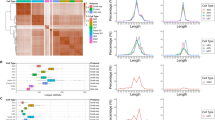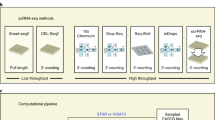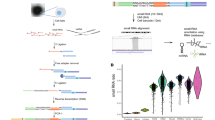Abstract
Little is known about the heterogeneity of small-RNA expression as small-RNA profiling has so far required large numbers of cells. Here we present a single-cell method for small-RNA sequencing and apply it to naive and primed human embryonic stem cells and cancer cells. Analysis of microRNAs and fragments of tRNAs and small nucleolar RNAs (snoRNAs) reveals the potential of microRNAs as markers for different cell types and states.
This is a preview of subscription content, access via your institution
Access options
Subscribe to this journal
Receive 12 print issues and online access
$209.00 per year
only $17.42 per issue
Buy this article
- Purchase on Springer Link
- Instant access to full article PDF
Prices may be subject to local taxes which are calculated during checkout


Similar content being viewed by others
References
Sandberg, R. Nat. Methods 11, 22–24 (2014).
Kolodziejczyk, A.A., Kim, J.K., Svensson, V., Marioni, J.C. & Teichmann, S.A. Mol. Cell 58, 610–620 (2015).
Fan, X. et al. Genome Biol. 16, 148 (2015).
Ha, M. & Kim, V.N. Nat. Rev. Mol. Cell Biol. 15, 509–524 (2014).
Taft, R.J. et al. RNA 15, 1233–1240 (2009).
Thompson, D.M., Lu, C., Green, P.J. & Parker, R. RNA 14, 2095–2103 (2008).
Sharma, U. et al. Science 351, 391–396 (2016).
Hayes, J., Peruzzi, P.P. & Lawler, S. Trends Mol. Med. 20, 460–469 (2014).
Landgraf, P. et al. Cell 129, 1401–1414 (2007).
Kivioja, T. et al. Nat. Methods 9, 72–74 (2011).
Kebschull, J.M. & Zador, A.M. Nucleic Acids Res. 43, 143–152 (2015).
Fu, H. et al. FEBS Lett. 583, 437–442 (2009).
Lee, Y.S., Shibata, Y., Malhotra, A. & Dutta, A. Genes Dev. 23, 2639–2649 (2009).
Sperber, H. et al. Nat. Cell Biol. 17, 1523–1535 (2015).
Zhang, Z. et al. Stem Cell Reports 4, 645–657 (2015).
Rosa, A., Papaioannou, M.D., Krzyspiak, J.E. & Brivanlou, A.H. Dev. Biol. 391, 81–88 (2014).
Kim, H. et al. Cell Stem Cell 8, 695–706 (2011).
Cavaillé, J. et al. Proc. Natl. Acad. Sci. USA 97, 14311–14316 (2000).
Picelli, S. et al. Nat. Methods 10, 1096–1098 (2013).
Lu, J. et al. Nature 435, 834–838 (2005).
Theunissen, T.W. et al. Cell Stem Cell 15, 471–487 (2014).
Dobin, A. et al. Bioinformatics 29, 15–21 (2013).
Van der Maaten, L. & Hinton, G. Journal of Machine Learning. 9, 2579–2605 (2008).
Kharchenko, P.V., Silberstein, L. & Scadden, D.T. Nat. Methods 11, 740–742 (2014).
Acknowledgements
We thank J. Muhr and D. Topcic (Ludwig Institute for Cancer Research, Stockholm) for providing glioblastoma cells, and W. Kang for constructive comments on the computational pipeline. This work was supported by Knut and Alice Wallenberg Foundation (2015.0096) (F.L.), the Swedish Research Council (F.L. and R.S.), Ragnar Söderberg Foundation (F.L.), the Swedish Foundation for Strategic Research (F.L. and R.S.), the Bert L. and N. Kuggie Vallee Foundation (R.S.) and the European Research Council (648842) (R.S.).
Author information
Authors and Affiliations
Contributions
O.R.F. conceived the study, developed the method, interpreted the results and prepared the manuscript. I.A. constructed the bioinformatics pipeline, analyzed the data, prepared the figures and contributed to manuscript text. M.H.-J. helped optimize the protocol and constructed libraries, J.P.S. and F.L. contributed naive and primed embryonic stem cells. R.S. supervised the development of the method and the computational analyses, and prepared the manuscript.
Corresponding authors
Ethics declarations
Competing interests
O.R.F. and R.S. have filed a patent application on the protocol for single-cell small-RNA sequencing.
Integrated supplementary information
Supplementary Figure 1 Schematic outline of the single-cell small-RNA library preparation.
Single cells were lysed directly in the preparation tube and 5.8S rRNA was masked for adapter ligation immediately by a complementary oligo. Then, the 3' adapter was ligated to the small RNAs and the free adapter was removed enzymatically prior to the 5' adapter ligation. The 5' adapter contains a unique molecular identifier (UMI) to remove PCR replicates. Sequences required for Illumina cluster generation and sample indexing were added through two rounds of PCR amplifications.
Supplementary Figure 3 Estimation of the sequencing errors and evaluation of the UMI correction method.
We designed seven synthetic RNA oligos that we subjected to library preparation and subsequently sequenced the resulting library. In the analyses, we treated their first eight nucleotides as UMIs and we calculated the percentage of mismatches that occurs during PCR amplifications and sequencing reaction. In the barplot we summarized the percentage of sequenced reads with mismatches before and after using the adjacency method to collapse reads to UMIs. The results show that the adjacency method correctly collapsed all single bp mismatches into molecules and partially corrected for the reads that harbored two or more mismatched within the UMIs. The error bars represent standard deviation. Adjacency procedure is available at https://github.com/CGATOxford/UMI-tools
Supplementary Figure 4 Characteristics of small-RNA libraries and length profiles of mRNA-derived small-RNAs detected in the single cells.
(a) Numbers of genes per RNA species observed within the small RNAs libraries (18-40 nts). (b) Size distributions of mRNA-derived small RNAs profiled in single cells and per cell type. Error bars denote standard deviations. Peaks in length distribution were observed around 18 and 31 nts suggesting that these RNAs were processed products and were not the result of mRNA degradation.
Supplementary Figure 5 Comparison of miRNA differential expression in the single-cell data and in previous bulk-RNA analysis of naive and primed hESCs.
(a) Fraction of differentially expressed miRNAs detected when comparing naive and primed hESCs in bulk RNA measured by q-PCR (Sperber et al. Nat Cell Biol 2015) and in single-cell small-RNA sequencing data (Fig 1h). (b) Scatter plot of miRNAs expression in single naive and primed hESCs (Fig 1h), colored according to their differential expression of bulk data in Sperber et al. Nat Cell Biol 2015. The miRNAs identified as differentially expressed in single-cell data got colored according to whether the same miRNA was identified as significantly higher expressed in Naive (green) or Primed (blue) hESCs. Red circles denote miRNAs that were found significantly differentially expressed in our study but not in Sperber et al.
Supplementary Figure 6 Scatter plot of small-RNA expression in naïve and primed hESCs.
Analyses of tsRNA, sdRNA and mRNA-derived small RNAs in naive and primed hESCs. Genes in red were statistically significant, (assessed using SCDE: Single Cell Differential Expression analysis) requiring adjusted p-values below 0.05 and a 2-fold or larger difference in molecule counts between cell types. As in Fig 1h, 97 naïve and 90 primed cells were used.
Supplementary Figure 7 Variation of miRNA expression in primed and naïve hESCs.
(a) Spearman coefficients are reported for the correlation of miRNA expression among pairs of single cells within each cell type, as boxplots. Line in the middle of boxes represents median, and notches represent confidence interval around the median. Primed ESCs showed less correlation that was statistically significant among single cells compared to naive hESCs (Welch Two Sample t-test). (b) miRNA expression distributions across naive and primed hESCs in absolute molecule counts, for the miRNAs that showed biological variation in primed hESCs (Fig 1i). These miRNAs were abundant in naive hESCs but were only detected at high levels in a few primed hESCs. (c) Similar to (b) but for a selection of miRNAs that were differentially expressed and also showed no significant variation within naive nor primed hESCs. (a-c) Naive cells were sub-sampled according to the molecule distribution of primed cells in order to adjust for their differences in cell size.
Supplementary Figure 8 Variation of tsRNA and sdRNA expression in primed and naïve hESCs.
The absolute molecule counts data was normalized to adjust for the cell size difference, by sub-sampling molecules in primed cells to match the molecule distribution obtained for the smaller naive cells (see Materials and Methods for details). (a) Expression variation within primed and naïve hESCs (as Fig 1i) for tsRNAs and sdRNAs. (b) Distribution of molecule counts observed in single naive and primed hESCs, for the RNA genes with most variation within populations.
Supplementary Figure 9 Hierarchical clustering of single HEK293FT cells and human naive and primed ESCs.
(a) Clustering of single cells (columns) based on expression of miRNAs (rows). A number of miRNAs (128) were expressed exclusively in naive hESCs but not in HEK293FT nor primed hESCs. (b) The miRNAs were found uniquely expressed in naive hESCs.
Supplementary Figure 10 Clustering of an extended number of cell types.
Clustering of primed and naïve hESCs, HEK293FT cells and glioblastoma cells using miRNA expression with t-distributed stochastic neighbor embedding (t-SNE). Analysis included total 398 cells and 585 miRNAs expressed (>=1 molecule) in at least 2 cells. The number of cells used for each cell type is indicated inside parenthesis in the legend. Independent experimental replicates were performed for primed and naïve hESCs in order to evaluate the batch effect.
Supplementary Figure 11 miRNAs detection in dilutions of HEK293FT RNA and in single cells.
Scatter plots of miRNA expression on diluted HEK293FT RNA (1ug, 100ng, 10ng, 1ng, 0.1 ng, 0.01ng). Three replicates of 1ug profiles on the y-axis were plotted against three replicates of profiles generated from lower amounts of starting total RNA (x-axis). In the last row, profiles from 1ng HEK293FT total RNA was compared to the profiles obtained on three individual HEK29FT cells. Spearman coefficients are reported in top right corners.
Supplementary Figure 12 Comparison of small-RNA profiling using single-cell method and the NEBNext method.
Small-RNA sequencing libraries were generated from 1000 ng of HEK293FT RNA and we excluded the size selection step in the NEBNext protocol to make it directly comparable to our data (as we do not use any size selection step). Scatter plots summarized the profiling of miRNAs (a), tsRNAs (b) and sdRNAs (c) using the NEBNext protocol (x-axis) against single-cell small-RNA sequencing data (y-axis). Comparisons against different replicates generated with the same protocol are shown for NEBNext (d) and small-RNA single-cell sequencing protocol (e). Spearman correlation was computed by adding pseudocount of 1 to all samples. Dropouts are seen as small RNAs only detected with one method. Genes with a 40-fold or larger difference in expression between methods were colored red (higher in single-cell small-RNA protocol) and blue (higher in NEBNext protocol).
Supplementary information
Supplementary Text and Figures
Supplementary Figures 1–12 and Supplementary Tables 1 and 2 (PDF 2262 kb)
Supplementary Table 3
Sequencing statistics of single-cell small RNA libraries (XLSX 46 kb)
Supplementary Software
Python scripts for processing the small-RNA sequence library data (ZIP 12696 kb)
Rights and permissions
About this article
Cite this article
Faridani, O., Abdullayev, I., Hagemann-Jensen, M. et al. Single-cell sequencing of the small-RNA transcriptome. Nat Biotechnol 34, 1264–1266 (2016). https://doi.org/10.1038/nbt.3701
Received:
Accepted:
Published:
Issue Date:
DOI: https://doi.org/10.1038/nbt.3701
This article is cited by
-
Discovery of the major 15–30 nt mammalian small RNAs, their biogenesis and function
Nature Communications (2023)
-
MGcount: a total RNA-seq quantification tool to address multi-mapping and multi-overlapping alignments ambiguity in non-coding transcripts
BMC Bioinformatics (2022)
-
A comparative analysis of single cell small RNA sequencing data reveals heterogeneous isomiR expression and regulation
Scientific Reports (2022)
-
Comparative Analysis of microRNAs that Stratify in vitro Mammary stem and Progenitor Activity Reveals Functionality of Human miR-92b-3p
Journal of Mammary Gland Biology and Neoplasia (2022)
-
Trophoblast derived extracellular vesicles specifically alter the transcriptome of endometrial cells and may constitute a critical component of embryo-maternal communication
Reproductive Biology and Endocrinology (2021)



